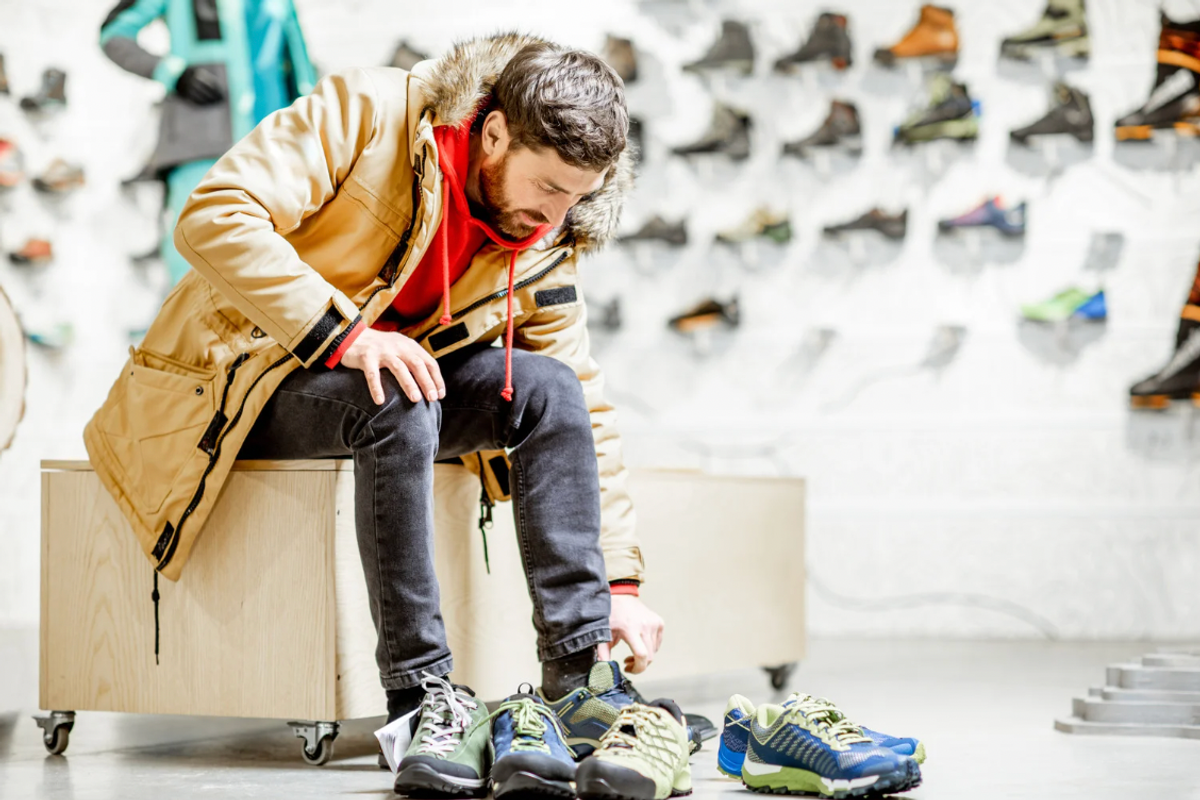Millennial parents are pleading with Boomer grandparents to stop giving excessive gifts to grandkids
"I struggle to keep on top of tidying as it is, and this is a massive added challenge."
Boomer grandparents are excessively gifting their grandkids, and Millennial parents have had enough.
Millennial parents and Boomer grandparents don't always see eye to eye on parenting and grandparenting. Now, Millennial parents are uniting on a nightmare Boomer grandparenting trend that sees them "excessively gifting" their grandkids with tons of both new and old *unwanted* stuff during visits.
Ohio mom Rose Grady (@nps.in.a.pod) shared her "Boomer grandparent" experience in a funny and relatable video. "Just a millennial mom watching her boomer parents bring three full loads of 'treasures' into her home," she wrote in the overlay.
Grady can be seen looking out the window of her home at her Boomer mom and dad carrying bags and boxes up her driveway after several visits. The distressed and contemplative look on Grady's is speaking to plenty of Millennial moms.
@nps.in.a.pod Today's "treasure" highlight was the mobile that hung in my nursery... #boomerparents #boomers #boomersbelike #millennialsoftiktok #millenialmom #motherdaughter
Grady captioned the video, "Today's 'treasure' highlight was the mobile that hung in my nursery..."
The humorous video resonated with with fellow Millennial parents. "Straight to the trash when they leave," one viewer commented. Another added, "I always say 'if you don’t want it in yours, we don’t want it in ours' 😂."
Even more Millennial parents have shared and discussed their situations with Boomer grandparents buying their kids too much stuff on Reddit. "Both my mother and my MIL love buying and sending toys, books, clothes, etc. I don't want to be ungrateful but we just don't need it and don't have the space. I have brought this up politely in 'we are all out of drawers for that' but it hasn't slowed things down," one explained. "I think part of the issue is that the grandparents live in different cities and vacation a lot. They don't get to see our daughter much so they buy stuff instead."
Another Millennial parent shared, "While the intention is very kind behind these, all the grandparents are very aware that we do not need, nor wish to receive these gifts in such an excessive volume - as it creates a daily struggle to store and accommodate in our home. I struggle to keep on top of tidying as it is, and this is a massive added challenge."

How to talk to Boomer grandparents about gifts
So, why are Boomer grandparents excessively gifting? "Boomer grandparents may be the first grandparent generation to have accumulated the substantial discretionary funds that enables them to spend money on their grandchildren," Sari Goodman, a Certified Parent Educator and founder of Parental Edge, tells Upworthy. "These grandparents probably grew up with grandparents who didn’t have that kind of money and so they may be excited to give their grandchildren the things they didn’t get."
Goodman suggests that Millennial parents first discuss with them the "why" behind the gifting. "What comes before setting a boundary to limit over-the-top gift-giving is delving into the reasons grandparents are buying so much," she explains. "Coming from a place of compassion and understanding makes it possible to come up with mutually beneficial solutions."
- YouTube www.youtube.com
She recommends that Millennial parents sit down with their Boomer parents to learn more. "Did they grow up without many toys and clothes and are fulfilling a dream? Ask them about the values they learned as children (hard work, perseverance, the power of delayed gratification) and how they can pass on these lessons to the grandchildren," she suggests.
She adds that another reason may be that Boomer grandparents live far away and want their grandchildren to feel a connection with them. "Set up a regular FaceTime or Zoom meeting. Rehearse with the kids so they have something to say and suggest a topic for the grandparents," says Goodman. "Or send snail mail. Kids love getting mail. The grandparents can send postcards from where they live and explain some of the special sites."

Finally, Goodman adds that for some grandparents, this may be is the only way they know how to show their love. Millennial parents could ask if they would be open to other ideas. "Parents can set up an activity for grandparents and kids to do when they come over—a jigsaw puzzle, art activity, board game, magic tricks," she says. "Arrange for the grandchildren to teach the grandparents something their phones can do or introduce them to an app they might like."
This article originally appeared last September
- Grandma has the perfect solution for grandparents who buy too many gifts for their grandkids ›
- Grandparents share their 'no-buy' things to do while spending time with grandkids ›
- Grandma offers wake-up call for grandparents who can't stop buying the grandkids presents ›
- Woman calls out boomer parents who 'beg' for grandchildren and then completely disappear - Upworthy ›
- 15 quirky boomer habits that frustrate millennials to the core - Upworthy ›
- Woman flawlessly reenacts how pre–holiday visit planning with her mother-in-law should go - Upworthy ›
- Elderly woman hilariously shares her 'not to do' list and it’s truly inspiring - Upworthy ›
- Boomers say stop wasting money on 'luxuries.' Millennial proves they have it backwards. - Upworthy ›




 Worried mother and children during the Great Depression era. Photo by Dorthea Lange via Library of Congress
Worried mother and children during the Great Depression era. Photo by Dorthea Lange via Library of Congress  A mother reflects with her children during the Great Depression. Photo by Dorthea Lange via Library of Congress
A mother reflects with her children during the Great Depression. Photo by Dorthea Lange via Library of Congress  Families on the move suffered enormous hardships during The Great Depression.Photo by Dorthea Lange via Library of Congress
Families on the move suffered enormous hardships during The Great Depression.Photo by Dorthea Lange via Library of Congress
 A couple cooking in the kitchen with a cat sitting on the table beside chopped ingredients.
A couple cooking in the kitchen with a cat sitting on the table beside chopped ingredients.
9 comics that hilariously show our love/hate relationship with the internet.
The internet can be a wonderful, joy-filled, treasure trove of amazement.
But it can also be a dirge of sadness, anxiety, and general ennui.
In these hilarious comics, Sara Zimmerman of Unearthed Comics gives some insight into the pains, joys, and anxiety that we’ve all experienced online.
Science fiction writer William Gibson wrote in a prescient story for the New York Times way back in 1996: “As new technologies search out and lace over every interstice in the net of global communication, we find ourselves with increasingly less excuse for ... slack."
We share ourselves online in the hopes of being liked, but we are all terrified of being judged and being disliked, and it's hard to cut ourselves and the world some slack.
The internet allows us to connect with friends and family around the globe, watch the latest adorable video of a bulldog riding a skateboard, or ignore the endless pileup of emails in our inboxes.
That's why Zimmerman poignantly uses “The Eye of Sauron” as a metaphor for our anxiety over sharing some photos on Facebook. Because we’ve all had that nagging desire to have power over how many people like our post.
So here are some refreshing comics to give you some perspective on our love/hate relationship with the internet:
1. Love may be one thing we can count on to protect us.
All images by Sara Zimmerman/Unearthed Comics.
2. Being ahead of the game is important.
3. And knowing what works best is a good start.
4. Compassion is key for an enjoyable ride.
5. The simple things don't always turn out the way you plan.
6. It's good to have some perspective.
7. Job descriptions can be flexible.
8. Being productive has different meanings.
9. Time management can get complicated on the web.
These comics are a reminder of how silly the internet really is.
As of June 2016, Facebook reported having over 1.13 billion daily active users. That's a lot of people using just Facebook, let alone the rest of the internet. As technology becomes more ubiquitous around the globe we all grow a little closer but also share in the frustrations that digital communication holds.
So in light of everything the internet offers us, I think we should cut ourselves a little slack when it comes to our relationship with it.